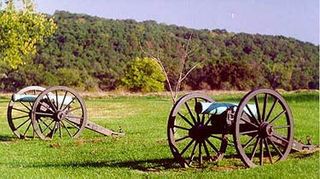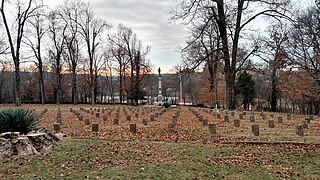
Fayetteville is the second-most populous city in the U.S. state of Arkansas, the county seat of Washington County, and the most populous city in Northwest Arkansas. The city had a population of 93,949 as of the 2020 census, which was estimated to have increased to 101,680 by 2023. The city is on the outskirts of the Boston Mountains, deep within the Ozarks. It was named after Fayetteville, Tennessee, from which many settlers had come, and was incorporated on November 3, 1836. Fayetteville is included in the three-county Fayetteville–Springdale–Rogers metropolitan statistical area, with 576,403 residents in 2020.

The Battle of Pea Ridge, also known as the Battle of Elkhorn Tavern, took place during the American Civil War near Leetown, northeast of Fayetteville, Arkansas. Federal forces, led by Brig. Gen. Samuel R. Curtis, moved south from central Missouri, driving Confederate forces into northwestern Arkansas. Maj. Gen. Earl Van Dorn had launched a Confederate counteroffensive, hoping to recapture northern Arkansas and Missouri. Confederate forces met at Bentonville and became the most substantial Rebel force, by way of guns and men, to assemble in the Trans-Mississippi. Against the odds, Curtis held off the Confederate attack on the first day and drove Van Dorn's force off the battlefield on the second. By defeating the Confederates, the Union forces established Federal control of most of Missouri and northern Arkansas.

Historic Washington State Park is a 101-acre (41 ha) Arkansas state park in Hempstead County, Arkansas in the United States. The museum village contains a collection of pioneer artifacts from the town of Washington, Arkansas, which is a former pioneer settlement along the Southwest Trail. Walking interpretive tours are available throughout the 54 buildings. Washington served as a major trading point along the Southwest Trail, evolving into the Hempstead county seat and later the capital of Arkansas from 1863 to 1865 when Little Rock was threatened during the Civil War. The original plat of Washington was added to the National Register of Historic Places in 1972 as the Washington Historic District.

The Battle of Wilson's Creek, also known as the Battle of Oak Hills, was the first major battle of the Trans-Mississippi Theater of the American Civil War. It was fought on August 10, 1861, near Springfield, Missouri.

The First Battle of Newtonia was fought on September 30, 1862, between Confederate soldiers commanded by Colonel Douglas H. Cooper and a Union column commanded by Brigadier General Frederick Salomon near Newtonia, Missouri, during the American Civil War. Cooper's force had moved into southwestern Missouri, and encamped near the town of Newtonia. The Confederate column was composed mostly of cavalry led by Colonel Joseph O. Shelby and a brigade of Native Americans. A Union force commanded by Brigadier General James G. Blunt moved to intercept Cooper's force. Blunt's advance force, led by Salomon, reached the vicinity of Newtonia on September 29, and attacked Cooper's position on September 30. A Union probing force commanded by Colonel Edward Lynde was driven out of Newtonia by Cooper's forces on the morning of the 30th.

Wilson's Creek National Battlefield, located near Republic, Missouri, preserves the site of the Battle of Wilson's Creek. Fought on August 10, 1861, the battle was the first major American Civil War engagement west of the Mississippi River. In the battle, a Confederate army commanded by Benjamin McCulloch and Sterling Price defeated a smaller Union army commanded by Nathaniel Lyon. However, the Confederates were unable to hold much of Missouri, and a Confederate defeat at the Battle of Pea Ridge effectively solidified Union control of the state. Major features include a five-mile automobile tour loop, the restored 1852 Ray House, and "Bloody Hill", the site of the final stage of the battle. The site is located near Republic in southwestern Missouri just southwest of the city of Springfield. It has been a unit of the National Park Service since 1960, and was listed on the National Register of Historic Places in 1966.

The Battle of Honey Springs, also known as the Affair at Elk Creek, on July 17, 1863, was an American Civil War engagement and an important victory for Union forces in their efforts to gain control of the Indian Territory. It was the largest confrontation between Union and Confederate forces in the area that would eventually become Oklahoma. The engagement was also unique in the fact that white soldiers were the minority in both fighting forces. Native Americans made up a significant portion of each of the opposing armies and the Union force contained African-American units.
The Camden Expedition was the final campaign conducted by the Union Army in south Arkansas during the Civil War. The offensive was designed to cooperate with Major-General Nathaniel P. Banks' movement against Shreveport.

During the American Civil War, Arkansas was a Confederate state, though it had initially voted to remain in the Union. Following the capture of Fort Sumter in April 1861, Abraham Lincoln called for troops from every Union state to put down the rebellion, and Arkansas along with several other southern states seceded. For the rest of the civil war, Arkansas played a major role in controlling the Mississippi River, a major waterway.

Bleak House is an antebellum Classical Revival style house in Knoxville, Tennessee. It is on the National Register of Historic Places.

The 1st Regiment Arkansas Volunteer Infantry (1863–1865) was an infantry regiment that served in the Union Army during the American Civil War. Although Arkansas joined the Confederate States of America in 1861, not all of its citizens supported secession. Arkansas formed some 48 infantry regiments to serve in the Confederate Army, but also formed another 11 regiments that served in the Union Army.

The West Dickson Street Commercial Historic District, known as Dickson Street, is an area in downtown Fayetteville, Arkansas just off the University of Arkansas campus. It is lined with multiple bars, restaurants, and shops unique to the area. Many large condo projects are now under construction as well. Dickson Street is home to the Walton Arts Center and is widely considered one of the two most popular entertainment districts in the state, along with the River Market District in downtown Little Rock.

The 1st Arkansas Cavalry Regiment (1862–1865) was a cavalry regiment from the state of Arkansas that served in the Union Army during the American Civil War.
Fort McCulloch was a Confederate military fort built by CSA Brigadier General Albert Pike in the Indian Territory during the American Civil War after the Battle of Pea Ridge.

The Battle of Fayetteville, also known as the Action at Fayetteville, took place during the American Civil War on April 18, 1863, in Fayetteville, Arkansas.

Fayetteville Confederate Cemetery is a cemetery for soldiers of the Confederate States located on the eastern side of Fayetteville in Washington County, Arkansas. Added to the National Register of Historic Places (NRHP) in 1993, the cemetery encompasses 3.5 acres (1.4 ha).
The 8th Arkansas Field Battery (1862–1865) was a Confederate Army artillery battery during the American Civil War. The battery spent its entire existence in the Department of the Trans-Mississippi. It was also known as Hughey's Battery.

Washington–Willow Historic District is a residential neighborhood of Fayetteville, Arkansas containing over one hundred historically and architecturally significant homes. Styles range from those popular in the mid-19th century through present day, predominantly Victorian, Italianate, neoclassical, and craftsman bungalows. Historically, Fayetteville leaders in business, law and education have all called the district home. The homes sit at the foot of East Mountain within the Masonic Addition, the first addition platted following incorporation.
The Civil War Trust's Civil War Discovery Trail is a heritage tourism program that links more than 600 U.S. Civil War sites in more than 30 states. The program is one of the White House Millennium Council's sixteen flagship National Millennium Trails. Sites on the trail include battlefields, museums, historic sites, forts and cemeteries.
Jonas March Tebbetts was an American salesman, reporter, lawyer, prosecutor, judge, abolitionist, unionist, politician, and judge in the United States.

















